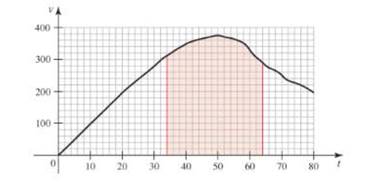
Concept explainers
Free fall On October 14, 2012, Felix Baumgartner stepped off a balloor capsule at an attitude of a most 39 km above Earth’s surface and began his free fall. His velocity in m/s during the fall is given in the figure. It is claimed that Felix reached the speed of sound 34 seconds into his fall and that he continued to fall at supersonic speed for 30 seconds. (Source: http://www.redbullstratos.com)
a. Divide the interval [34, 64] into n – 5 subintervals with the gridpoints x0 – 34, x1 – 40, x2 – 46, x3 – 52, x4 – 58, and x3 = 64. Use left and right Riemann sums to estimate how far Felix fall while travelling at supersonic speed.
b. It is claimed that the actual distance that Felix fell at supersonic speed was approximately 10.495 m. Which estimate in part (a) produced the more accurate estimate?
c. How could you obtain more accurate estimates of the total distance fallen than those found in part(a)?

Want to see the full answer?
Check out a sample textbook solution
Chapter 5 Solutions
EP CALCULUS:EARLY TRANS.-MYLABMATH ACC.
Additional Math Textbook Solutions
College Algebra (7th Edition)
Precalculus
Algebra and Trigonometry (6th Edition)
A Problem Solving Approach To Mathematics For Elementary School Teachers (13th Edition)
Elementary Statistics (13th Edition)
 Glencoe Algebra 1, Student Edition, 9780079039897...AlgebraISBN:9780079039897Author:CarterPublisher:McGraw HillAlgebra & Trigonometry with Analytic GeometryAlgebraISBN:9781133382119Author:SwokowskiPublisher:Cengage
Glencoe Algebra 1, Student Edition, 9780079039897...AlgebraISBN:9780079039897Author:CarterPublisher:McGraw HillAlgebra & Trigonometry with Analytic GeometryAlgebraISBN:9781133382119Author:SwokowskiPublisher:Cengage
 Trigonometry (MindTap Course List)TrigonometryISBN:9781305652224Author:Charles P. McKeague, Mark D. TurnerPublisher:Cengage Learning
Trigonometry (MindTap Course List)TrigonometryISBN:9781305652224Author:Charles P. McKeague, Mark D. TurnerPublisher:Cengage Learning Algebra and Trigonometry (MindTap Course List)AlgebraISBN:9781305071742Author:James Stewart, Lothar Redlin, Saleem WatsonPublisher:Cengage Learning
Algebra and Trigonometry (MindTap Course List)AlgebraISBN:9781305071742Author:James Stewart, Lothar Redlin, Saleem WatsonPublisher:Cengage Learning





